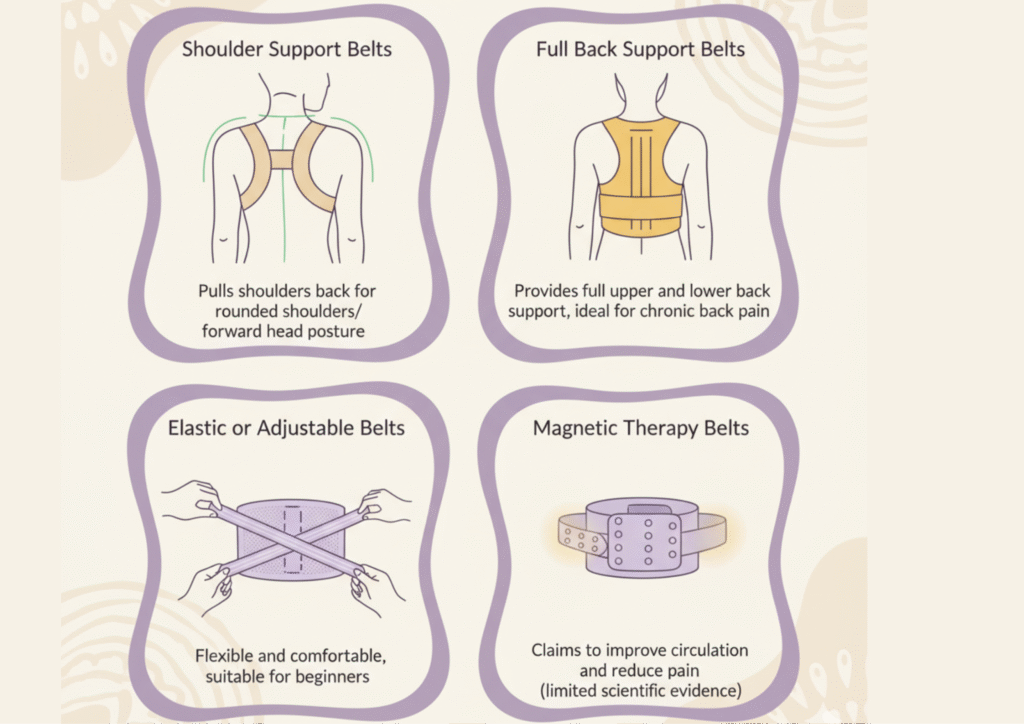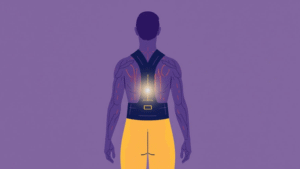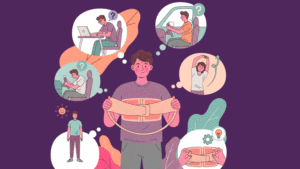With the long desk hours, endless scrolling, and work-from-home routines becoming the norm these days, posture correction belts have quickly gained popularity in 2025. They promise an easy, wearable fix for slouched shoulders and stiff backs, something many of us struggle with daily.
These belts work by gently pulling your shoulders back and aligning your spine, reminding your body of its natural upright position. The result? Reduced back and neck pain, better posture awareness, and improved confidence over time.
But with so many options available, how do you choose the right one? Let’s dive in and explore different types of posture correction belts and their comparative alternatives to discover which one suits and works for you the best.
Different Types of Posture Correction Belts and How They Work

Not all posture belts are created equal. Here’s a breakdown of the most common types:
1. Shoulder Support Belts
These belts are specifically designed to pull the shoulders back, which supports your body to stay upright, ideal for people with rounded shoulders or forward head posture. They’re lightweight and discreet, making them suitable for daily wear.
2. Full Back Support Belts
These belts provide comprehensive support, covering your upper and lower back. They’re beneficial for people with chronic back pain or those who spend long hours sitting.
3. Elastic or Adjustable Belts
Made from breathable materials, these belts are very flexible and comfortable. They’re perfect for beginners or those looking for a lightweight option.
4. Magnetic Therapy Belts
Incorporating magnets, these belts claim to improve blood circulation and reduce pain. While some users report benefits, scientific evidence is limited.
Each type has its unique advantages. Consider your specific needs and lifestyle when choosing.
How to Choose the Right Posture Belt?
Let’s be honest, choosing the right posture belt is a task in itself. Here are some basic checkpoints you must consider while buying a posture correction belt:
- Comfort: Look for breathable, lightweight materials.
- Adjustability: Ensure the belt can be customized to your body size.
- Support Level: Choose based on your specific needs: shoulder support, full back support, or elastic flexibility.
- Material Quality: Opt for durable materials that can withstand daily use.
Remember, consistency is key. Incorporating the belt into your daily routine, along with complementary products, can lead to significant improvements in posture and overall well-being.
Beyond Posture Correction Belts: Effective Ways to Improve Posture !
Posture correction belts are a great way to gently remind your body to remain aligned.They work well for many people, but depending on your needs, there are various other effective alternatives for improving posture.
Ergonomic solutions like lumbar cushions, supportive chairs, smart posture gadgets, or even footwear aids can complement or replace a belt, helping your body maintain natural alignment while keeping your muscles active and comfortable. Think of them as a variety of tools in your posture toolkit, each designed to support you in the way that works best for you.
Top Affordable Smart Alternatives to Posture Correction Belts (That Really Work)
Time to meet the real heroes of posture correction, the everyday tools that improve your spine health without breaking the bank.
1. Lumbar Support Cushions : Everyday Relief for Your Lower Back
If you’re spending half your life sitting in the office, in the car, or at home, your lower back is quietly begging for support.
That’s where Betterhood’s Lumbar Support Cushion steps in. Designed with ergonomic contours, it cradles your spine’s natural curve and reduces pressure on the lumbar region. The result? Less slouching, more comfort, and a lower risk of chronic pain .
These cushions are especially great for desk workers who lean forward to squint at their screens or for drivers spending hours in traffic. Studies show that lumbar supports can significantly improve posture and reduce muscle fatigue during prolonged sitting.
2. Coccyx Seat Cushions: Sit Without Tailbone Pain
We often blame our chairs for being uncomfortable, but sometimes, it’s our sitting posture that’s the real culprit.
The betterhood Coccyx Cushion is a clever, affordable fix. With a U-shaped cut-out design, it relieves pressure on your tailbone (coccyx) and distributes weight evenly across your hips. This design helps prevent tailbone pain, sciatica, and even poor circulation.
Real talk: sitting for eight hours can feel like slow torture for your spine. But with a coccyx cushion, you’re not just sitting; you’re giving your tailbone a well-deserved day off.
3. Ergonomic Foam Backrest, Headrest & Seat Cushion : Set Full-Body Support on a Budget
Imagine getting full spinal support from your head to your hips without spending thousands on an ergonomic chair. That’s exactly what betterhood’s Ergonomic Memory Foam Set does.
This trio (backrest, headrest, and seat cushion) provides balanced alignment, reduces shoulder strain, and encourages neutral spine posture. According to ergonomics research, combined cushioning that supports multiple spinal regions can improve sitting comfort and posture efficiency by up to 40% [8].
Perfect for home offices, gaming setups, or long drives, it’s a posture upgrade your back will thank you for daily.
4. Smart Posture Trainers: Tiny Devices, Big Reminders
If you’re the forgetful type (we’ve all been there), a smart posture trainer can nudge you when you start slouching. These wearable devices vibrate gently when you hunch your shoulders, reminding you to straighten up.
While they don’t replace physical support, they complement posture corrector tools by keeping you aware and active in your posture journey. Studies show that biofeedback-based tools significantly improve posture awareness in just a few weeks.
5. Posture Correction Chairs: Sit Smarter
A posture correction chair supports your spine, neck, and shoulders while encouraging natural alignment. With features like adjustable lumbar support and headrests, it helps you sit comfortably for long hours without slouching. Pair it with a lumbar cushion or seat pad for extra comfort and better posture throughout the day.
6. Heel Pads & Orthotic Inserts: The Silent Posture Fix No One Talks About
Most people think posture correction starts at the back, but it actually begins at the feet. Misalignment or uneven pressure on your feet can alter the way your spine carries your body weight.
That’s why Betterhood’s Orthotic Gel Heel Pads are an underrated hero. These inserts absorb shock, balance your gait, and promote better alignment all the way up your spine.
Research confirms that even minor adjustments in foot positioning can correct spinal posture and reduce lower back pain [11]. In other words, happy feet = happy spine.
7. Foam Rollers and Resistance Bands: Train Your Posture Muscles Naturally!
You don’t always need equipment that supports your back; sometimes, you need tools that teach your back to support itself.
Foam rollers and resistance bands are affordable, space-friendly, and perfect for building postural strength. A few minutes of thoracic spine rolling or shoulder band exercises daily can reduce stiffness and promote muscular endurance.
Remember, consistency is key. Incorporating the belt into your daily routine, along with complementary products, can lead to significant improvements in posture and overall well-being.
Simple Natural Posture Fixes You Can Do for Free !
The best posture correction tools work best when paired with small, mindful daily habits:
- Sit with both feet flat on the floor.
- Keep screens at eye level to avoid “tech neck.”
- Take short stretch breaks every hour.
- Do wall checks; stand with your head, shoulders, and hips against the wall for a few seconds to realign.
These habits reinforce what your ergonomic tools are doing; giving you a long-term, natural posture correction plan without extra spending. [13]
Brand Reviews : Best Posture Correctors in India (2025)
Based on reviews and user feedback, here are some top picks:
| Brand | ProductType | Key Features | Ideal For |
| betterhood | Lumbar Support Cushion | 100% memory foam, ergonomic contours, breathable fabric, non-slip base | Office workers, long drivers, home loungers |
| Tynor | Shoulder Support Belt | Lightweight, washable, adjustable sizes | Mild slouchers, daily wear |
| Boldfit | Elastic Posture Belt | Premium neoprene fabric, adjustable Velcro straps | Active users, gym-goers |
| Kossto | Full Back Support Belt | Flexible metal stays, 3-in-1 support (upper, lower, abdomen) | Chronic back pain sufferers |
| HealthSense | Elastic Posture Belt | Soft spandex neoprene, suitable for all-day wear | Budget-conscious users |
Expert Tips to Maximise Results from Your Posture Support Tools
Improving your posture is less about quick fixes and more about building small, consistent habits. Here’s how to get the most out of your posture support tools:
1. Mix and match support for full comfort
Combine different tools to support multiple areas of your body. For example, use a coccyx seat cushion with a lumbar backrest. This way, your lower back and tailbone are both supported, reducing slouching and discomfort during long work or study sessions.
2. Adjust your chair and desk setup
Simple tweaks can make a big difference. Keep your hips slightly higher than your knees and your feet flat on the floor. Adjust your screen to eye level so you’re not craning your neck. Even small changes like these help your spine stay aligned naturally.
3. Take micro-movement breaks
Sitting for hours can stiffen your muscles. Set a timer every hour to stand up, stretch, or walk for just two minutes. Roll your shoulders, reach overhead, or do a gentle twist to wake up your spine. Over time, these mini breaks reduce fatigue and reinforce better posture.
4. Ease into it gradually
Your muscles need time to adjust. Alternate between using support tools and free sitting to gradually strengthen your core and postural muscles. Think of it like training for a marathon — start slow and steady, rather than forcing it all at once.
5. Treat posture improvement as a lifestyle, not a race
Remember, perfect posture doesn’t happen overnight. Celebrate small wins, like sitting taller during your morning meeting or feeling less tension after a long drive. Consistency matters more than intensity, small, daily adjustments build lasting habits.
By combining support tools with mindful habits, you can make upright posture feel natural, comfortable, and even effortless, all without straining your back or shoulders.
Common Mistakes People Make When Switching from a Belt?
Even with the right tools, a few classic mistakes can ruin your progress:
- Relying only on the cushion: It’s there to support, not substitute for movement.
- Skipping strengthening exercises: Weak core = recurring posture problems.
- Choosing low-quality foam: Cheap materials flatten quickly, defeating the purpose.
- Ignoring ergonomics: Even the best cushion can’t fix a poorly adjusted chair height.
Avoid these traps, and you’ll see results faster, without ever strapping yourself into another belt.
Real People, Real Results: Stories Behind Better Posture
A driver’s story: Ravi used to feel stiff after long commutes. Switching to a lumbar cushion and posture belt combo made him feel lighter and more relaxed within weeks.
A student’s story: Nisha used a posture corrector bra for subtle daily support. Paired with a memory foam seat cushion, her back pain reduced without bulky gear.
A gamer’s story: Arjun swapped his chair for an ergonomic setup and added heel pads to improve balance. His posture and focus both improved.
Real results don’t come overnight; they come from smart habits and consistent support.
Final Thoughts
At the end of the day, better posture isn’t about gadgets or quick fixes, it’s about building awareness and creating small daily habits that your body thanks you for. You don’t need to overthink it; a comfy cushion here, a stretch there, and mindful sitting can go a long way.
Remember, posture improvement is more of a gentle journey than a strict routine. Stay consistent, move often, and maybe smile while you straighten up, it helps more than you think.
Explore More Health & Wellness Solutions
Want to stay informed about wellness and everyday health issues? Here are some insightful reads to guide you. Explore the links below for practical tips and solutions:-
- Simple Posture Exercises to Fix Slouching and Neck Strain
- Posture Correction Belts vs Posture Braces: Which Works Best?
- How to Reduce Back Pain While Sitting at Home or Work
- Can a Posture Corrector Belt Help Athletes to Recover?
Frequently Asked Questions
1. What can I use instead of a posture correction belt?
Try lumbar cushions, posture corrector bras, ergonomic chairs, or heel pads. These support posture naturally without restriction.
2. Is a posture correction chair a good option?
Absolutely! A posture chair supports your entire spine, not just your shoulders. Pairing it with a lumbar or seat cushion enhances comfort and encourages proper alignment for long hours of sitting.
3. Can a posture corrector bra help with slouching?
Yes. A posture bra gently pulls shoulders back and supports upper-back muscles, improving alignment to some extent over time.
4. Are coccyx cushions good for posture?
Yes. A coccyx cushion reduces tailbone pressure and keeps your spine upright, ideal for long sitting hours.
5. How do heel pads improve posture?
Orthotic heel pads correct foot alignment, balancing your hips and spine to reduce back and neck strain.
6. How can I maintain good posture at home?
Combine ergonomic supports, like lumbar or coccyx cushions, with regular movement breaks, stretches, and mindful sitting. Small daily habits make a big difference in building lasting posture awareness.
References
- Leung, M., Kan, M. M. P., Cheng, H. M. H., De Carvalho, D. E., Anwer, S., Li, H., & Wong, A. Y. L. (2023). Effects of using a shoulder/scapular brace on the posture and muscle activity of healthy university students during prolonged typing: A randomized controlled cross-over trial. Healthcare, 11(11), 1555. https://doi.org/10.3390/healthcare11111555
- Bai, J., et al. (2023). Effects of non-extensible lumbar belts on static and dynamic postural stability in healthy male participants. Frontiers in Sports and Active Living.https://pmc.ncbi.nlm.nih.gov/articles/PMC10165835/?utm_source=chatgpt.com
- Hospital for Special Surgery. (2021, March 8). Do posture correctors work? Expert advice from a PT. HSS Health Library https://www.hss.edu/health-library/move-better/do-posture-correctors-work?utm_source=chatgpt.com
- Arabloo, J., Hamouzadeh, P., Eftekharizadeh, F., Mobinizadeh, M., Olyaeemanesh, A., & Nejati, M. (2017). Health technology assessment of magnet therapy for relieving pain. Med J Islam Repub Iran., 31, 31.https://www.researchgate.net/publication/318734484_Health_technology_assessment of_magnet_therapy_for_relieving_pain
- Simpson, L., Maharaj, M. M., & Mobbs, R. J. (2019). The role of wearables in spinal posture analysis: a systematic review. BMC musculoskeletal disorders, 20(1), 55.https://pmc.ncbi.nlm.nih.gov/articles/PMC6368717/
- Grondin, D. E., Triano, J. J., Tran, S., & Soave, D. (2013). The effect of a lumbar support pillow on lumbar posture and comfort during a prolonged seated task. Chiropractic & manual therapies, 21(1), 21.https://pmc.ncbi.nlm.nih.gov/articles/PMC3766244/
- Li, W., Mo, R., Yu, S., Chu, J., Hu, Y., & Wang, L. (2020). The effects of the seat cushion contour and the sitting posture on surface pressure distribution and comfort during seated work. International Journal of Occupational Medicine and Environmental Health, 33(5), 675-689.https://ijomeh.eu/pdf-123512-55135?filename=55135.pdf
- Franz, M., Durt, A., Desmet, P., & Zenk, R. (2012). Comfort effects of a new car headrest with neck support. Applied Ergonomics, 43(2), 245-253.https://www.sciencedirect.com/science/article/abs/pii/S0003687011000822
- Pereira, A. P., dos Santos, M. D. G. C., & Mazuquin, B. (2025). Wearable smartphone-based multisensory feedback system improves posture awareness during rehabilitation: A within-subjects pilot study. JMIR Aging, 8, e55455. https://doi.org/10.2196/55455
- van Niekerk, S.-M., Louw, Q. A., & Hillier, S. (2012). The effectiveness of a chair intervention in the workplace to reduce musculoskeletal symptoms: A systematic review. BMC Musculoskeletal Disorders, 13, 145.https://pmc.ncbi.nlm.nih.gov/articles/PMC3552974/
- Chen, H., Han, J., & Zhai, J. (2024). Effect of orthopedic insoles on lower limb motion kinematics and kinetics: A systematic review. Frontiers in Bioengineering and Biotechnology, 12, 11273083https://pmc.ncbi.nlm.nih.gov/articles/PMC11273083/
- Wiewelhove, T., Diallo, A., Petit, P. D., de Oliveira Silva, M., Volker, K., & Ferrauti, A. (2019). A meta‐analysis of the effects of foam rolling on flexibility, recovery, and performance. Sports Medicine, 49(5), 731-744. https://pmc.ncbi.nlm.nih.gov/articles/PMC6465761/
- Kim, D. J., et al. (2015). Effect of an exercise program for posture correction on musculoskeletal pain. Journal of Physical Therapy Science, 27(6), 1743-1746.https://pmc.ncbi.nlm.nih.gov/articles/PMC4499985/



















